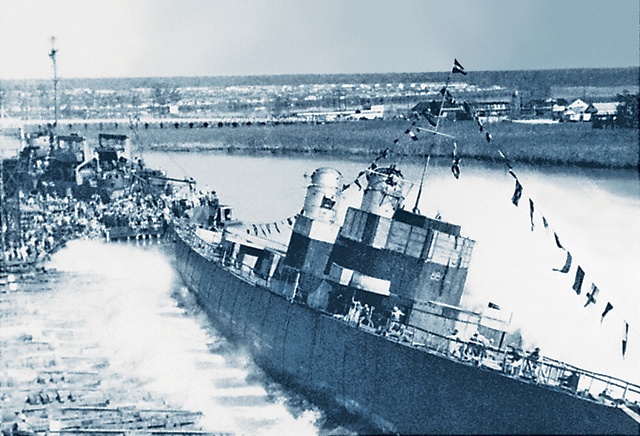The city of Orange, on Texas’ eastern border, was nearly wiped out by the Depression despite a proud history of lumbering and shipbuilding on the banks of the Sabine River near the Gulf of Mexico. In the 1930s, Orange was broke. The population had dwindled. A mere 8 percent of residents had jobs. Businesses were shuttered, and farms were repossessed.
But then the Japanese attacked Pearl Harbor, and the United States entered World War II. Overnight, Orange became a bustling metropolis, helping supply the largest navy in the world as one of the nation’s leading shipbuilding towns.
Because Orange already had shipbuilding infrastructure, U.S. Navy officials arrived with lucrative contracts in hand. Steel fabricator Consolidated Western Steel Corp. built a shipyard, and the existing Levingston and Weaver shipbuilding companies expanded. Within a few months, these three companies created thousands of jobs. People came from everywhere: nearby communities and farms, East and North Texas, the swamps of Louisiana and hills of Oklahoma. From 1941 to 1945, Orange’s population ballooned from a few thousand to about 70,000.
Production churned around the clock. The bright lights of the shipyards illuminated the revamped downtown 24 hours a day. The bustle of people coming and going at all hours, the hammering and drilling of sheet metal and the pneumatic pounding of rivets made night like day. Young boys stood at the gates of shipyards at midnight hawking newspapers, shoeshines and anything else they could find to sell.
New service businesses opened up. Cleaners, shoe repairs, auto shops, barbershops and grocery stores could not keep up with demand. Employers opened early, closed late and tried to keep wages competitive with those of the shipyards to retain help. Every commodity was in short supply: dry goods, canned goods, clothing, auto parts, construction materials and fresh food. Local gardeners and farmers sold produce before it ripened and eggs before they were laid.
A housing shortage drove people to live in tents, fields, barns and sheds. To solve the problem, the federal government bulldozed sand into a marsh and built more than 4,500 temporary homes in a development called Riverside. Because Riverside bordered the Sabine River, the ground was always wet. Concrete streets, designed as drains, channeled the water when it rained, but there was nowhere for it to go. Even if a Riverside resident could afford a car, it couldn’t make it through the streets; therefore, people walked barefoot to their homes.
Educated locals filled office and supervisory positions, mingling with naval officers and administrators from other parts of the country. Uneducated workers attended school and trained for specific jobs. They became machinists, welders or fabricators in a matter of weeks. Even with all of the workers descending on the town, Orange needed more. Women entered the workforce.
Young single women from farms and widowed women whose husbands were killed overseas—many with children to support—joined the ranks. Even townswomen lined up to work, donning pants and hardhats to the shock of some of their neighbors.
To the surprise of many men, women proved to be great workers in the shipyards, eagerly learning, paying attention to detail and taking their jobs seriously. In small areas, women’s smaller hands and statures were big assets. But women weren’t restricted to dainty work. They tackled grueling projects and didn’t complain, even when shooting hot rivets deep in the hull of a ship, enduring 100-degree heat.
Collectively, the community of Orange produced hundreds of ships, including the USS Aulick—the first warship from Texas to enter active service. Consolidated Steel produced 39 destroyers and 110 destroyer escorts, well-armed, fast-moving warships that protected troop carriers and other large ships. In four years, Levingston Shipbuilding built 160 vessels: barges, small river and large ocean tugboats, tenders to ferry supplies and messages. Weaver Shipbuilding completed 135 minesweepers made from wood to deter German magnetic explosives.
Nine other major U.S. shipbuilders bolstered the American fleet during World War II, most of them near large cities such as Pittsburgh, Jacksonville, Florida, Los Angeles and Houston, areas that touted huge workforces. Per capita, however, the once tiny town of Orange outproduced them all.
——————–
Ginger Mynatt is a fiction writer and freelance journalist living in Sherman.


